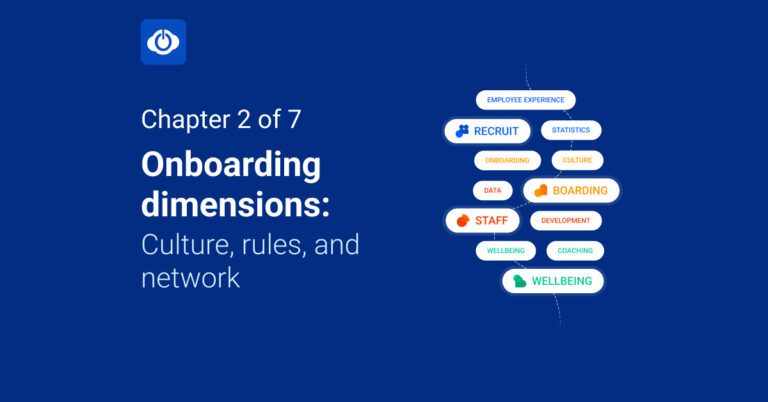Chapter 2 of 7:
Understanding the onboarding dimensions? How to work with culture, rules, and network from day one
How do you create a start where new employees understand the company, feel welcome, and find their place? The answer rarely lies in one significant onboarding activity – but instead in the dimensions you work with from the very beginning.
Following Chapter 1 of our HR-ON All the Way series, where we explored the entire employee journey, we now move into the beginning of onboarding – the parts that lay the foundation for everything that follows.
Especially now, when attention on AI has skyrocketed, onboarding is a perfect opportunity to show new employees that their competencies matter and will be put to use, particularly in a time where the challenge of AI “is really less about the technology and more about trust and relationships.“
This chapter focuses on three of the six dimensions of The Onboarding Model©, developed by Christian Harpelund and Morten T. Højlund, and explained in detail in the book Onboarding: Getting New Hires off to a Flying Start (Danish; Onboarding – Flyvende fra start which we will use as point of reference in this blog post).
You’re reading a chapter in our new blog series: HR-ON All the Way
A series of HR guides that give you practical insights and tools for every part of the employee journey – no matter where you are today.
You are here:
Chapter 2 – Understanding the onboarding dimensions? How to work with culture, rules, and network from day one
Why you should use the onboarding dimensions
In Onboarding: Getting New Hires off to a Flying Start, Christian Harpelund and Morten T. Højlund present six dimensions based on The Onboarding Model©:
- Culture
- Rules
- Network
- Collaboration
- Competencies
- Performance
In this blog post, we dive into the first three onboarding dimensions: culture, rules, and network. You’ll gain concrete ideas on how to make these dimensions a more integrated, living part of your onboarding – for both you, as the onboarding manager, and the new colleagues who begin their journey here.
And it’s also a good time to introduce you to HR-ON Boarding, our onboarding platform that helps you build connection and clarity from day one.
CONTENT
Why you should use the onboarding dimensions
Culture: Help employees understand “who we are”
Rules: Create safety with clarity and structure
Network: Give employees access to people, not just information
Reflect: How strong is your onboarding in the three dimensions?
The onboarding dimensions can give you a clear picture
FAQ: What are onboarding dimensions?
Culture: Help employees understand “who we are”
Culture isn’t posters or value statements on your website or office walls. It’s what a new employee feels in small moments: the tone, the pace, the patience.
When company culture isn’t introduced deliberately, it becomes random. And randomness creates uncertainty, especially during the first weeks, when new employees read the room far more than they read your systems. Ultimately, a missing or poorly explained culture can lead employees in a direction that harms their wellbeing and productivity.
How to strengthen the culture dimension:
- Share your informal norms
- Use examples instead of value headlines
- Let the team explain how daily life actually works
- Use onboarding flows in HR-ON Boarding to show culture in small, digestible pieces
A strong cultural introduction helps new colleagues feel safe faster because they know what they’re stepping into. Spend time helping the new employee understand:
- The company’s vision, direction, and strategy
- The company’s unwritten rules
- The company’s stories, norms, and values
You might also like: 5 Tips: How to Recruit for a Strong Work Culture
Rules: Create safety through clarity and structure
Rules may sound boring, but they create calm. Unclear expectations lead to insecurity; clear boundaries foster confidence. Many onboarding processes become vague simply because no one is entirely clear on when you’re “allowed” to ask, challenge, share, or say stop.
Gallup highlights the same challenge: less than half of employees strongly agree that they know what is expected of them at work – a sharp drop compared to before the pandemic. It’s a clear reminder of how important it is to make expectations and rules concrete, especially in the first weeks when everything is new.
Strengthen the rules dimension by:
- Making expectations clear, not just in week 1, 2, and 3
- Explaining what is must-know versus nice-to-know
- Showing where information lives, not just sending links
- Gathering materials in one place so that new employees don’t have to search
When rules are clear, employees can spend their energy learning – not guessing.
How we do it at HR-ON
When a new colleague is introduced to our company rules, we start with our employee manifesto. It’s a central onboarding touchpoint where the new hire can read the manifesto and ask questions. Of course, there’s an adjustment period, but colleagues are always available if questions pop up.
Network: Give employees access to people, not just information
An employee who doesn’t know who to turn to quickly ends up feeling alone – even if colleagues are friendly.
Network isn’t about being shown around and introduced to 12 people on day one. It’s about real access points: Who helps me when I get stuck? Who can I interrupt? Who should I ask about KPIs?
Without these answers, new employees expend a significant amount of energy interpreting, guessing, and holding back, slowing down their start.
When relationships aren’t established early, a new employee can feel like a guest far longer than anyone intends.
How to strengthen the network dimension:
- Create a buddy system that supports both practical and social onboarding
- Introduce key collaborators through real tasks
- Make space for informal touchpoints: a walk, a coffee, a quick intro during lunch
When a network becomes a genuine onboarding priority, not a checkbox, attachment develops faster, and attachment is the basis for engagement.
Reflect: How strong is your onboarding in the three onboarding dimensions?
We’ve now covered the first three of the six dimensions in The Onboarding Model©. But what now?
A good next step is this reflection exercise, inspired by the ‘Onboarding – Flying Start‘ concept.
Even though we haven’t covered all six dimensions yet, take the time to evaluate where your onboarding process can improve.
Reflection exercise
- List all activities in your current onboarding process
- Place each activity under one of the six dimensions:
- Culture, rules, network, collaboration, competencies, performance
Notice:
- Which dimensions have many activities?
- Which have none?
- Where is there a lack of balance?
After the exercise, you might discover that you’ve worked hard on culture, but perhaps the network is weaker. That’s okay. Now you have a clear picture of what your onboarding does well and where there’s room to grow.
You might also like: Onboarding New Employees: 10 Strategies for Knowledge Development
The onboarding dimensions can give you a clear picture
A good start, that’s what matters. Welcoming the new employee well and ensuring they’re happy to have landed in this role and this company.
With the onboarding dimensions, and an onboarding tool as your helper, you’ll get a clearer picture of how strong your onboarding really is.
In the next chapter, we focus on the remaining three dimensions: collaboration, competencies, and performance, providing you with a comprehensive 360° view of your onboarding process.
In the meantime, if you’d like to learn more about HR-ON Boarding, you can book a demo with our sales team or try our price calculator.
FAQ: What are onboarding dimensions?
What are onboarding dimensions?
Onboarding dimensions encompass six essential areas that collectively create a structured and robust onboarding experience. The model is based on the Onboarding Model, as developed by Christian Harpelund and Morten T. Højlund.
Which six dimensions exist?
Culture, rules, network, collaboration, competencies, and performance.
How do you use the onboarding dimensions in practice?
By reviewing your onboarding flow and ensuring each dimension is addressed, for example, culture through small examples, rules through clear expectations, and network through relationship-building.
What happens if the dimensions are missing?
Onboarding becomes random. Employees guess more than they learn, increasing the risk of insecurity, lower engagement, and faster turnover.
How does HR-ON work with onboarding dimensions?
HR-ON Boarding makes it easy to build onboarding flows that cover all six dimensions through small, manageable steps, so new colleagues experience a start that’s both warm and well-structured.




